Goalkeeper (association football)
The goalkeeper, often shortened to keeper or goalie, is one of the major positions of association football. It is the most specialised position in the sport. The goalkeeper's primary role is to prevent the opposing team from scoring (moving the ball over the defended goal-line within the frame of the goal). This is accomplished by the goalkeeper moving into the path of the ball and either catching it or directing it away from the vicinity of the goal line. Within the penalty area goalkeepers are able to use their hands, making them (outside throw-ins) the only players on the field permitted to handle the ball. The special status of goalkeepers is indicated by them wearing different coloured kits from their teammates.
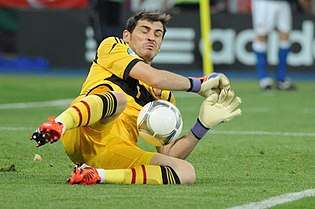
The back-pass rule prevents goalkeepers handling direct passes back to them from teammates. Goalkeepers usually perform goal kicks, and also give commands to their defence during corner kicks, direct and indirect free kicks, and marking. Goalkeepers play an important role in directing on field strategy as they have an unrestricted view of the entire pitch, giving them a unique perspective on play development. The goalkeeper is the only required position of a team. If they are injured or sent off, a substitute goalkeeper has to take their place, otherwise an outfield player must take the ejected keeper's place in goal. In order to replace a goalkeeper who is sent off, a team usually substitutes an outfield player for the backup keeper (thus effectively the red card and substitution takes out two of the starting eleven players). They then play the remainder of the match with nine outfield players. If a team does not have a substitute goalkeeper, or they have already used all of their permitted substitutions for the match, an outfield player has to take the dismissed goalkeeper's place and wear the goalkeeper shirt.
The squad number for a first choice goalkeeper is generally number 1, although they may wear any jersey number between 1 and 99.[1]
History
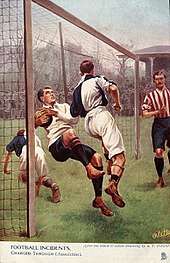
Association football, like many sports, has experienced many changes in tactics resulting in the generation and elimination of different positions. Goalkeeper is the only position that is certain to have existed since the codification of the sport. Even in the early days of organised football, when systems were limited or non-existent and the main idea was for all players to attack and defend, teams had a designated member to play as the goalkeeper.
The earliest account of football teams with player positions comes from Richard Mulcaster in 1581 and does not specify goalkeepers. The earliest specific reference to keeping goal comes from Cornish Hurling in 1602. According to Carew: "they pitch two bushes in the ground, some eight or ten foot asunder; and directly against them, ten or twelve score off, other twayne in like distance, which they term their Goals. One of these is appointed by lots, to the one side, and the other to his adverse party. There is assigned for their guard, a couple of their best stopping Hurlers".[2] Other references to scoring goals begin in English literature in the early 16th century; for example, in John Day's play The Blind Beggar of Bethnal Green (performed circa 1600; published 1659): "I'll play a gole at camp-ball" (an extremely violent variety of football, popular in East Anglia). Similarly, in a 1613 poem, Michael Drayton refers to "when the Ball to throw, And drive it to the Gole, in squadrons forth they goe". It seems inevitable that wherever a game has evolved goals, some form of goalkeeping must also be developed. David Wedderburn refers to what has been translated from Latin as to "keep goal" in 1633, though this does not necessarily imply a fixed goalkeeper position.
The word "goal-keeper" is used in the novel Tom Brown's School Days (published in 1857, but set in the 1830s). The author is here referring to an early form of rugby football:
You will see in the first place, that the sixth-form boy, who has the charge of goal, has spread his force (the goal-keepers) so as to occupy the whole space behind the goal-posts, at distances of about five yards apart; a safe and well-kept goal is the foundation of all good play.[3]
The word "goal-keeper" appeared in the Sheffield Rules of 1867, but the term did not refer to a designated player, but rather to "that player on the defending side who for the time being is nearest to his own goal". The goal-keeper, thus defined, did not enjoy any special handling privileges.[4]
The FA's first Laws of the Game of 1863 did not make any special provision for a goalkeeper, with any player being allowed to catch or knock-on the ball.[5] Handling the ball was completely forbidden (for all players) in 1870.[6] The next year, 1871, the laws were amended to introduce the goalkeeper and specify that the keeper was allowed to handle the ball "for the protection of his goal".[7] The restrictions on the ability of the goalkeeper to handle the ball were changed several times in subsequent revisions of the laws:
- 1871: the keeper may handle the ball only "for the protection of his goal".
- 1873: the keeper may not "carry" the ball.[8]
- 1883: the keeper may not carry the ball for more than two steps.[9]
- 1887: the keeper may not handle the ball in the opposition's half.[10]
- 1901: the keeper may handle the ball for any purpose (not only in defence of the goal).[11]
- 1912: the keeper may handle the ball only in the penalty area.
- 1931: the keeper may take up to four steps (rather than two) while carrying the ball.[12]
- 1992: the keeper may not handle the ball after it has been deliberately kicked to him/her by a team-mate.
- 1997: the keeper may not handle the ball for more than six seconds.
Initially, goalkeepers typically played between the goalposts and had limited mobility, except when trying to save opposition shots. Throughout the years, the role of the goalkeeper has evolved, due to the changes in systems of play, to become more active. The goalkeeper is the only player in association football allowed to use their hands to control the ball (other than during throw-ins).
During the 1935–36 English football season, young Sunderland AFC goalkeeper of the team, Jimmy Thorpe, died as a result of a kick in the head and chest after he had picked up the ball following a backpass in a game against Chelsea at Roker Park. He continued to take part until the match finished, but collapsed at home afterwards and died in hospital four days later from diabetes mellitus and heart failure 'accelerated by the rough usage of the opposing team' [13] his tragic end to Thorpe's career led to a change in the rules, where players were no longer allowed to raise their foot to a goalkeeper when he had control of the ball in his arms.[14]
Due to several time-wasting techniques which were used by goalkeepers, such as bouncing the ball on the ground or throwing it in the air and then catching it again, in the 1960s, the Laws of the game were revised further, and the goalkeeper was given a maximum of four steps to travel while holding, bouncing or throwing the ball in the air and catching it again, without having to release it into play. The FIFA Board later also devised an anti-parrying rule, saying that such deliberate parrying for the purpose of evading the Law was to be regarded also as holding the ball.[15]
In 1992, the International Football Association Board made changes in the laws of the game that affected goalkeepers – notably the back-pass rule,[16] which prohibits goalkeepers from handling the ball when receiving a deliberate pass from a teammate that is made with their feet. This rule change was made to discourage time-wasting and overly defensive play after the 1990 FIFA World Cup which was described as exceedingly dull, rife with back-passing and goalkeepers holding the ball. Also, goalkeepers would frequently drop the ball and dribble it around, only to pick it up again once opponents came closer to put them under pressure, a typical time-wasting technique. Therefore, another rule was introduced at the same time as the back-pass rule. This rule prohibits the goalkeeper from handling the ball again once he or she has released it for play; an offence results in an indirect free kick to the opposition. Furthermore any player negating the spirit of the new rule would be likely to be cautioned for unsporting behaviour and punished by an indirect free-kick.[15]
On 1 July 1997, FIFA decided to extend the back-pass rule by applying it also to throw-ins from defenders to their own goalkeeper; in order to prevent further time-wasting, FIFA also established that if a goalkeeper holds the ball for more than five or six seconds the referee must adjudge this as time-wasting and award an indirect free-kick to the opposing team.[15]
Laws of the Game and general play
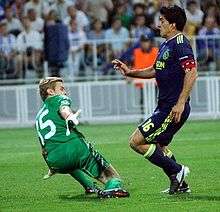
The position of goalkeeper is the only position in the game which is technically distinct from the others in the course of normal play. The Laws of the Game distinguish the goalkeeper from the other players in several ways, most significantly exempting them from the prohibition on handling the ball, though only within their own penalty area.[17] Once a goalkeeper has control of the ball in their hands, opponents are not permitted to challenge them.[17] Goalkeepers have a specialised role as the sole defender against a penalty kick.[17] Goalkeepers are required to wear distinct colours from other players, and are permitted to wear caps and tracksuit bottoms.[17]
The Laws mandate that one player on the team must be designated as the goalkeeper at all times, meaning that if a goalkeeper is sent off or injured and unable to continue another player must assume the goalkeeper position.[17] The Laws allow for teams to change the player designated as goalkeeper at stoppages in play,[17] but in practice this is rarely exercised.
The Laws place no restrictions on a goalkeeper leaving their penalty area and acting as an ordinary player, though generally goalkeepers stay close to their goal throughout the match.
Goalkeepers routinely perform extension dives. To execute this, they push off the ground with the foot nearest to the ball, launching themselves into a horizontal position. At this point, the ball may be caught or parried away from the goal. In the latter case, a good goalkeeper will attempt to ensure that the rebound cannot be taken by a player of the opposing team, although this is not always possible.
Responsibilities
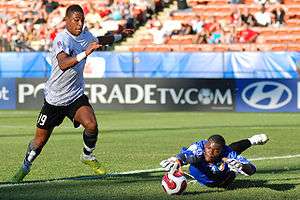
The tactical responsibilities of goalkeepers include:
- To keep goal by physically blocking attempted shots with any part of their body. The keeper is permitted to play the ball anywhere on the field, but may not handle the ball using hands or outstretched arms outside his/her penalty area.
- To organise the team's defenders during defensive set pieces such as free kicks and corners. In the case of free kicks, this includes picking the numbers and the organisation of a defensive man "wall". The wall serves to provide a physical barrier to the incoming ball, but some goalkeepers position their wall in a certain position to tempt the kick-taker to a certain type of shot. Occasionally, goalkeepers may opt to dispense with the wall. Some goalkeepers are also entrusted with the responsibility of picking markers while defending at set pieces.
- To pick out crosses and attempted long passes either by collecting them in flight or punching them clear if heavily challenged by opposing strikers.
Although goalkeepers have special privileges, including the ability to handle the ball in the penalty area, they are otherwise subject to the same rules as any other player.
Playmaking and attack
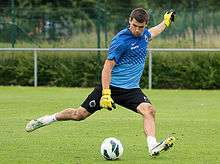
Goalkeepers are not required to stay in the penalty area; they may get involved in play anywhere on the pitch, and it is common for them to act as an additional defender (or 'sweeper') during certain passages of the game. Goalkeepers with a long throwing range or accurate long-distance kicks may be able to quickly create attacking positions for a team and generate goal-scoring chances from defensive situations, a tactic known as the long ball.
Sweeper-keeper
Gyula Grosics from the Hungary "Golden Team" of the 1950s was thought to be the first goalkeeper to play as the 'sweeper-keeper'.[19] Tommy Lawrence has also been credited with revolutionising the role of the goalkeeper by effectively acting as an 11th outfield player.[20] The rushing playing style used by Liverpool legend Bruce Grobbelaar seen during the 1980s–90s makes him one of the original sweeper-keepers of the modern era.[21] René Higuita was another who became known for his unorthodox, skillful but sometimes reckless techniques.[22] As of 2011, Manuel Neuer has been described as a sweeper-keeper due to his speed and unique style of play which occasionally includes him acting as a sweeper for his team by rushing off his line to anticipate opposing forwards who have beaten the offside trap.[23][24] With his excellent ball control and distribution, which enables him to start plays from the back,[23][24] he has said he could play in the German third division as a centre-back if he wanted to.[25][26] Hugo Lloris of Tottenham Hotspur and France and former goalkeepers Fabien Barthez and Edwin van der Sar, have also been described as sweeper-keepers,[27][28] while Claudio Bravo and Ederson Moraes of Manchester City have even been described as playmakers in the media.[29][30][31]
Other players who have been labelled "sweeper-keepers" in the media include Marc-Andre Ter Stegen of FC Barcelona and Germany, Spanish former goalkeeper Víctor Valdés, and former Soviet keeper Lev Yashin, the latter of whom is often cited by pundits as one of the goalkeepers who pioneered the role of the sweeper-keeper.[32] Sweeper-keepers have been popularised by managers who usually employ tactics inspired by total football, such as Johan Cruyff and Pep Guardiola, for example, and are chosen not only for their shot-stopping and goalkeeping abilities, but also due to their skill with the ball at their feet, their ability to pick out passes and contribute to the build-up play of their team, and their speed when rushing out of the penalty area to anticipate opponents, which enables their team to maintain a high defensive line. However, sweeper-keepers have also been associated with recklessness on occasion, sometimes putting their own team in danger; for example, Manuel Neuer's rushing into the midfield, leaving the goal exposed in his team's final group match against South Korea at the 2018 World Cup, led to a goal being conceded, after he had been robbed of the ball.[33]
Goalscorers

Some goalkeepers have scored goals. Other than by accident when a long kicked clearance reaches the other end of the field and evades the opposing goalkeeper with the aid of strong winds and/or unexpected bounces, this most commonly occurs where a goalkeeper has rushed up to the opposite end of the pitch to give his team a numerical advantage in attack, leaving his own goal undefended. As such, it is normally only done late in a game at set-pieces where the consequences of scoring far outweigh those of conceding a further goal, such as for a team trailing in a knock-out tournament.
Some goalkeepers, such as Higuita, Rogério Ceni, Hans-Jörg Butt and José Luis Chilavert, are also expert set-piece takers. These players may take their team's attacking free kicks or penalties. Ceni, São Paulo's long-time custodian, has scored 132 goals in his career, more than many outfield players.[34][35]
Equipment and attire

Goalkeepers must wear kit that distinguishes them clearly from other players and match officials, as this is all that the FIFA Laws of the Game require. Some goalkeepers have received recognition for their match attire, like Lev Yashin of the Soviet Union, who was nicknamed the "Black Spider" for his distinctive all-black outfit;[36][37] Klaus Lindenberger of Austria, who designed his own variation of a clown's costume; Jorge Campos of Mexico, who was popular for his colourful attire;[38] Raul Plassmann of Cruzeiro Esporte Clube and his all-yellow outfit; and Gábor Király for wearing a pair of grey tracksuit bottoms instead of shorts.[39]
Although it was initially more common for goalkeepers to wear long-sleeved jerseys, recently several goalkeepers, such as Gianluigi Buffon, have also been known to wear short-sleeves.[40][41][42][43]
Most goalkeepers also wear gloves to improve their grip on the ball, and to protect themselves from injury. Some gloves now include rigid plastic spines down each finger to help prevent injuries such as jammed, fractured, and sprained fingers. Though gloves are not mandatory attire, it is uncommon for goalkeepers to opt against them due to the advantages they offer. At UEFA Euro 2004, Portuguese goalkeeper Ricardo famously took off his gloves during the quarter-final penalty shoot-out against England, knowing he was the next taker for his side. He then went on to save Darius Vassell's penalty using his bare hands before scoring his own kick to win it for Portugal.[44]
Though rare, goalkeepers are permitted to wear visored headgear (such as a baseball cap) to minimize glare from bright sunlight, or a knit cap to insulate from cold weather, at any time if they elect to do so.
After recovering from a near-fatal skull fracture that he had sustained in 2006, Petr Čech has subsequently worn a rugby style headguard during his matches.[45][46]
Careers and injuries
Goalkeepers have a very physically demanding job. They are the only players allowed to use their hands, except for throw-ins. Because of this, goalkeepers are often injured during breakaways, corner kicks, and free kicks since they put their bodies on the line. Several famous goalkeepers have been injured in ways their counterparts could not possibly sustain. For example, Petr Čech received a head injury after colliding with another player during a 2006 game. He made his debut match a couple of months later wearing a rugby-style headpiece. However, some goalkeepers manage to avoid injury and continue to play, many not retiring until their late thirties or early forties. Notably, Peter Shilton played for thirty-one years between 1966 and 1997 before retiring at the age of forty-seven.
In general, goalkeepers can sustain any injury to which their outfield counterparts are vulnerable. Common lower and upper extremity injuries include cartilage tears, anterior cruciate ligament tears, and knee sprains. On the other hand, goalkeepers rarely fall victim to fatigue-related injuries, such as leg cramps, pulled hamstrings, and dehydration.[47]
Records
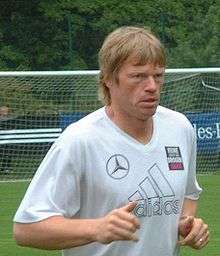
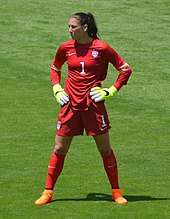
Goalkeepers are crucial in penalty shootouts. The record for most penalties saved in a shootout is held by Helmuth Duckadam of Steaua București in the 1986 European Cup Final against Barcelona[48] and Ciarán Kelly who saved all 4 penalties for Sligo Rovers against Shamrock Rovers in the 2010 FAI Cup Final.[49] Stefano Tacconi is the only goalkeeper to have won all official club competitions for which he was eligible.[50]
José Luis Chilavert is the only goalkeeper to score a hat-trick (three goals in a game), doing so through penalty kicks. Rogério Ceni has scored the most goals for a goalkeeper, having scored his hundredth goal in official games on 27 March 2011. Ceni scored his goals through free kicks and penalty kicks.[51]
Gianluigi Buffon is the only goalkeeper to have won the UEFA Club Footballer of the Year Award.[52] Oliver Kahn holds the record for most UEFA Best Club Goalkeeper and Best European Goalkeeper Awards with four.[53] Iker Casillas holds the record for most appearances by a goalkeeper in the FIFPro World XI and in the UEFA Team of the Year and most IFFHS World's Best Goalkeeper Awards, alongside Buffon,[54] winning the award for five consecutive years between 2008 and 2012.[55] Casillas holds the record for the most clean sheets in UEFA Champions League history.[56]
At the international level, Dino Zoff has remained unbeaten for the longest period of time,[57] whilst Walter Zenga holds the record for longest unbeaten run in a FIFA World Cup tournament at five hundred seventeen minutes.[58] Gianluigi Buffon, Fabien Barthez and Iker Casillas hold the record for fewest goals conceded by a winning goalkeeper in a World Cup tournament at two each. Buffon is the only World Cup–winning goalkeeper not to have conceded a goal in open play throughout the entire tournament, one goal having resulted from an own goal after a free kick, the other from a penalty. Fabien Barthez and Peter Shilton hold the record for most clean sheets in World Cup matches with ten each Mohamed Al-Deayea holds the record for most international caps by a goalkeeper with one hundred seventy-eight official appearances for Saudi Arabia.[59]
Pascal Zuberbühler holds the record for fewest goals conceded by a goalkeeper in a World Cup tournament and holds the record for most successive matches at an international tournament without conceding a goal with five. He did not concede a goal in four hundred sixty-three minutes of World Cup play against France, Korea, and Togo—making Switzerland the only team in the history of the tournament not to concede a goal in normal time. Tim Howard holds the record for most saves made in a FIFA World Cup match, with sixteen against Belgium in the 2014 Round of 16. Oliver Kahn is the only goalkeeper to have won the Adidas Golden Ball for the best player of the tournament in a World Cup (in the 2002 competition); Lev Yashin is the only goalkeeper to have won the Ballon d'Or. Gianluca Pagliuca of Italy became the first goalkeeper to be sent off in a World Cup Finals match, dismissed for handling outside his area against Norway in 1994. His team went on to win 1–0 and reached the final before losing to Brazil in a penalty shootout, in which he became the first goalkeeper ever to stop a penalty in a final shootout.
Iker Casillas holds both the record for fewest goals conceded in a European Championship with one in 2012) and the record for longest unbeaten run at a European Championship, beating the previous record held by Dino Zoff.[60] He also holds the records for most international clean sheets (one hundred two) by a male goalkeeper, beating the previous record held by Edwin van der Sar (seventy-two), and became the first goalkeeper in history, male or female, to keep one hundred clean sheets at international level in 2015; he also shares the overall record for the most international clean sheets along with Hope Solo.[61][62] Buffon holds the record for most minutes without conceding a goal in European Championship Qualifying matches at six hundred forty-four.[63]
Highest fees
As of August 2018, the most expensive goalkeeper of all time was Kepa Arrizabalaga following his 2018 €80 million (£71 million) transfer to Chelsea from Athletic Bilbao.
See also
| Wikimedia Commons has media related to Association football goalkeepers. |
Notes
- Part of the fees was paid via the transfer of Jonathan Bachini to Parma[69] for a total of 100 billion lire; the fixed exchange rate of lira to euro was 1936.27 lire to 1 euro.[70]
- £25m plus £5m bonuses[73]
- 55 billion lire; Toldo and Rui Costa were originally signed by Parma for a total of 140 billion lire;[75][76] they were re-sold from Parma to Inter and Milan respectively after the two players refused to join Parma
- Reported figure
- 40 billion lire. Part of the transfer fee paid via the transfer of Marco Ballotta to Inter for 7 billion lire.[81][82]
- Much part of the fees was paid via the transfer of Sérgio Conceição to Inter (32 billion lire[66]) for a total of 40 billion lire
- Reported figure, if including other fee was €19.4m.[85] Part of the transfer fee was paid via the transfer of Davide Faraoni to Udinese for €8 million.[85] At the same time, both Udinese and Inter bought back 50% registration rights for half of the nominal fee (reported €9.5m and €4m respectively), as co-ownership. On 19 June 2013, Handanović and Faraoni were acquired by their new clubs for undisclosed fees.
- €18m plus €2m in bonuses
- 33 billion lire. Part of the transfer fee paid via the transfer of Alessandro Rinaldi to Atalanta (for 6 billion lire)[89][90]
- 28 billion lire
- €12.2m plus €3.1m in bonuses
References
- Khalil Garriot (21 June 2014). "Mystery solved: Why do the best football players wear No. 10?". Yahoo!. Retrieved 19 May 2015.
- "The Survey of Cornwall by Richard Carew". Retrieved 1 February 2013.
- An Old Boy [Thomas Hughes] (1857). School Days at Rugby. Boston: Ticknor and Fields. p. 112.
- Sheffield Football Association (1867). – via Wikisource.
- Football Association (1863). – via Wikisource.
- Football Association (1870). – via Wikisource.
- Football Association (1871). – via Wikisource.
- Football Association (1873). – via Wikisource.
- Football Association (1883). – via Wikisource.
- International Football Association Board (1887). – via Wikisource.
- International Football Association Board (1901). – via Wikisource.
- "Football". Carluke & Lanark Gazette: 3. 19 July 1931.
- "Goalkeeper's Death". The Times. London. 14 February 1936.
- "On the run with dogs and a long-dead goalkeeper - Telegraph". London. Archived from the original on 11 March 2007.
- "Goalkeepers are not above the Law". FIFA. 31 October 1997. Retrieved 19 July 2017.
- "From 1863 to the Present Day". FIFA. Retrieved 1 February 2013.
- "Laws". International Football Association Board | IFAB. International Football Association Board. Retrieved 8 February 2018.
- Ryan, Mathew (12 June 2013). "Mathew Ryan is a young, Australian keeper with good reflexes and a very good set of feet". clubbrugge.be. Archived from the original on 7 July 2015. Retrieved 12 June 2013.
- "The 50 Greatest Goalkeepers in History". Bleacher Report. 27 September 2013. Retrieved 28 September 2015.
- James Lawton (27 November 2001). "Fabien Barthez: The goalkeeper's fear of losing it". The Independent. Retrieved 16 January 2018.
- "Archived copy". Archived from the original on 8 May 2015. Retrieved 12 September 2017.CS1 maint: archived copy as title (link)
- Tim Vickery (10 February 2010). "The Legacy of Rene Higuita". BBC. Retrieved 11 June 2014
- "Manuel Neuer and the evolution of the goalkeeper". FourFourTwo. Retrieved 9 January 2015.
- "Why Manuel Neuer should not win the Ballon d'Or". The Score. Retrieved 9 January 2015.
- "Why Manuel Neuer was the best player at the 2014 World Cup". The42. 14 July 2014. Retrieved 16 July 2014.
- Vipond, Paddy (16 July 2014). "How Manuel Neuer, Germany's 11th man, is revolutionising goalkeeping". The Guardian. Retrieved 16 July 2014.
- Wilson, Jonathan (13 February 2014). "Tottenham's Hugo Lloris is Premier League's supreme sweeper-keeper". The Guardian. Retrieved 11 May 2017.
- Samuel Luckhurst (30 March 2015). "Manchester United: David de Gea has made goalkeeping cool". Manchester Evening News. Retrieved 13 January 2018.
- "'Man City's Claudio Bravo is a playmaker not sweeper-keeper'". BBC. Retrieved 11 December 2016.
- Jonathan Wilson (7 December 2018). "Ederson leads way as a ball-playing Premier League midfielder in gloves". The Guardian. Retrieved 21 January 2019.
- Steve Douglas; Mauricio Savarese (18 October 2017). "'The Brick Wall': Ederson solving keeper issues at Man City". USA Today. Retrieved 21 January 2019.
- Burford, Harry (24 December 2017). "Football Tactics for Beginners- The Sweeper Keeper Explained". The False 9. Retrieved 19 October 2019.
- "Neuer's kamikaze play punished against Korea". Yahoo Sports. 27 June 2018. Retrieved 29 October 2019.
- "Rogerio Ceni: Sao Paulo keeper into club record books". BBC. 4 June 2015. Retrieved 3 April 2016.
- "They said it: Jose Luis Chilavert". FIFA. 24 September 2010. Retrieved 13 March 2013.
- ""Yashin, the impregnable Spider"". FIFA. Retrieved 23 November 2013
- Lomas, Mark (29 April 2010) ""Lev Yashin: Russian Revolutionary"". Archived from the original on 22 May 2014.CS1 maint: BOT: original-url status unknown (link) ESPN. Retrieved 21 May 2014
- "Mexico's Jorge Campos: 'I'm not crazy!'". BBC World Service. 22 September 2015. Retrieved 28 June 2018.
- "Sportsworld – Euro 2016: Gabor Kiraly – Hungary's record breaker & his tracksuit bottoms?". BBC World Service.
- "Gianluigi Buffon". BBC Sport. 10 April 2002. Retrieved 4 June 2016.
- Matt Barker (24 March 2017). "Gianluigi Buffon, One-on-One: You have to be a real masochist to play in goal – and a bit perverse". FourFourTwo. Retrieved 13 June 2017.
- Gaetano Imparato (5 May 2012). "Zoff: "Sereno Buffon Resti un grande"". La Gazzetta dello Sport (in Italian). Retrieved 13 June 2017.
- Paolo Bandini (24 February 2015). "Still among football's elite, Juventus icon Buffon will be vital vs. Dortmund". The Score. Retrieved 13 June 2017.
- Portugal break England hearts; BBC Sport, 24 June 2004
- McNulty, Phil (20 January 2007). "Liverpool 2–0 Chelsea". BBC Sport. Retrieved 13 March 2012.
- Benammar, Emily (21 July 2008). "Petr Cech follows Zinedine Zidane in sponsorship deal". The Daily Telegraph. Retrieved 13 March 2012.
- Burger, Rob; Fine, Kenneth. "Soccer Injuries". Stop Sports Injuries. Retrieved 3 November 2015.
- "First goalkeeper who saved four consecutive penalties: Helmuth Duckadam set world record (Video)". worldrecordacedemy.com. 7 May 2011. Retrieved 20 August 2014.
- "Ciarán Kelly's 2010 shoot-out heroics - Greatest Aviva Moments". otbsports.com. 19 May 2020. Retrieved 28 May 2020.
- "Journey through the Stars: Stefano Tacconi". Juventus. 24 June 2011. Archived from the original on 24 December 2014. Retrieved 1 June 2015.
- The World's most successful goalscoring Goalkeepers of all time, IFFHS, 23 October 2006.
- "Buffon hailed after 500th Juventus appearance". Archived from the original on 10 February 2015. Retrieved 9 February 2015.
- "UEFA Club Goalkeeper of the Year". uefa.com. Retrieved 11 February 2015.
- "THE WORLD'S BEST GOALKEEPER 2017: GIANLUIGI BUFFON MAKES IT FIVE!". IFFHS.de. 3 December 2017. Retrieved 3 December 2017.
- "Iker Casillas named World's Best Goalkeeper by IFFHS". Retrieved 11 February 2015.
- Edward Bennett (23 April 2015). "Most clean sheets in Champions League history: Iker Casillas moves ahead of Chelsea & Man United legends". Retrieved 1 June 2015.
- "Dino Zoff". Retrieved 26 June 2012.
- "Zenga: I've Dedicated My Life to Football". Retrieved 26 June 2012.
- "Egypt's Ahmed Hassan equals international apperance [sic] record". BBC Sport. 15 November 2011. Retrieved 24 April 2017.
- Javier Estepa (2 July 2012). "Casillas, world record-breaking goalkeeper". Marca. Retrieved 1 June 2015.
- "International feats and a fitting farewell". FIFA. 30 May 2012. Retrieved 1 June 2015.
- "Casillas into three figures – 100 clean sheets for Spain". as.com. 13 November 2015. Retrieved 20 March 2018.
- "Buffon, felice per il record di imbattibilità". Retrieved 19 August 2013.
- "Kepa Arrizabalaga: Chelsea sign Athletic Bilbao goalkeeper in world record deal". BBC. 8 August 2018.
- "Alisson: Liverpool make Brazilian world's most expensive keeper". BBC. 19 July 2018.
- Parma A.C. S.p.A. bilancio (financial report and accounts) on 30 June 2002, PDF purchased from Italian C.C.I.A.A.(in Italian)
- "Rui Costa al Parma, Buffon alla Juve". La Repubblica (in Italian). 30 June 2001. Retrieved 2 July 2017.
- "Gianluigi Buffon". Football Database. Retrieved 2 September 2014.
- "Acquistato Buffon". Juventus F.C. (in Italian). 3 July 2001. Archived from the original on 7 September 2001. Retrieved 6 April 2010.
- ECB: Determination of the euro conversion rates
- "Ederson transferido para o Manchester City" [Ederson transferred to Manchester City] (Press release) (in Portuguese). S.L. Benfica. 1 June 2017. Archived from the original on 1 June 2017. Retrieved 1 June 2017.
- "Jordan Pickford: Everton confirm £25m, rising to £30m, deal with Sunderland". BBC Sport. 15 June 2017. Retrieved 16 June 2017.
- "Pickford Joins Everton In Club-Record Deal" (Press release). Everton F.C. 15 June 2017. Retrieved 2 July 2017.
- "Top 10: Das sind die teuersten Torhüter-Transfers der Fußballgeschichte" (in German). ran.de. July 2017. Retrieved 2 July 2017.
- A.C. Fiorentina S.p.A. bilancio (financial report and accounts) on 30 June 2001, PDF purchased from Italian C.C.I.A.A.(in Italian)
- "Toldo e Rui Costa al Parma Buffon a un passo dalla Juve". la Repubblica (in Italian). 29 June 2001. Retrieved 1 May 2013.
- "Bayern agree on Neuer transfer fee". FIFA. 14 May 2011. Archived from the original on 12 July 2013. Retrieved 5 February 2013.
- "Bernd Leno Transfer to Arsenal Completed, Bayer Leverkusen Announce". Bleacher Report. 20 June 2018. Retrieved 10 July 2018.
- "Manchester United confirm signing of David de Gea". BBC Sport. 29 June 2011. Retrieved 29 June 2011.
- F.C. Internazionale Milano S.p.A. bilancio (financial report and accounts) on 30 June 2000, PDF purchased from Italian C.C.I.A.A.(in Italian)
- "Peruzzi alla Lazio, adesso è fatta". La Gazzetta dello Sport (in Italian). 9 June 2000. Retrieved 2 July 2017.
- F.C. Internazionale Milano S.p.A. bilancio (financial report and accounts) on 30 June 2002, PDF purchased from Italian C.C.I.A.A.(in Italian)
- "Inter agree €11m fee for Handanovic, Udinese confirm". Goal.com. 4 July 2012. Retrieved 1 February 2013.
- "Inter, dopo Handanovic arriva anche Silvestre". Tuttosport (in Italian). 5 July 2012. Archived from the original on 14 October 2012. Retrieved 2 July 2017.
- F.C. Internazionale Milano S.p.A. bilancio (financial report and accounts) on 30 June 2013, PDF purchased from Italian C.C.I.A.A.(in Italian)
- "Claudio Bravo transferred to Manchester City" (Press release). F.C. Barcelona. 25 August 2016. Retrieved 2 July 2017.
- A.S. Roma S.p.A. bilancio (financial report and accounts) on 30 June 2001, PDF purchased from Italian C.C.I.A.A.(in Italian)
- "Pelizzoli, l'ex fenomeno diventato precario". Corriere della Sera (in Italian). 26 October 2002. Retrieved 4 July 2017.
- "Comandini, Sala, Dabo: l' Atalanta si fa grande". La Gazzetta dello Sport (in Italian). 30 June 2001. Retrieved 3 July 2017.
- "Lupatelli va al Chievo, Di Francesco a Piacenza" (in Italian). AS Roma. 29 June 2001. Archived from the original on 2 June 2002. Retrieved 1 April 2010.
- S.L. Benfica (16 July 2014). "Comunicado" [Communication] (PDF) (Press release) (in Portuguese). CMVM. Retrieved 2 July 2017.
- "Atletico Madrid agree deal for Benfica goalkeeper Jan Oblak". BBC Sport. 16 July 2014. Retrieved 29 July 2014.
- "Inter, scommessa da 200 miliardi". La Gazzetta dello Sport (in Italian). 28 June 1999. Retrieved 2 July 2017.
...Inseguendo Peruzzi, la societa' deve adesso affrontare un sacrificio di trentasei miliardi: ventotto del cartellino e otto di ingaggio lordo...
- Fifield, Dominic (29 June 2015). "Petr Cech seals £10m Arsenal move and tweets goodbye to Chelsea fans". The Guardian. Retrieved 29 June 2015.
- "Fraser Forster: Southampton sign Celtic goalkeeper for £10m". BBC. 9 August 2014. Retrieved 9 August 2014.
- "AGREEMENT WITH ARSENAL FOR THE DEFINITIVE ACQUISITION OF THE PLAYER WOJCIECH SZCZĘSNY" (PDF) (Press release). Juventus F.C. 19 July 2017. Retrieved 20 July 2017.
- "Fraser Forster: Barcelona sign Borussia Mönchengladbach goalkeeper for £9.7m". BBC. 9 August 2014. Retrieved 9 August 2014.
- "Marc-André ter Stegen signs 5-year contract" (Press release). F.C. Barcelona. 22 May 2014. Retrieved 2 July 2017.
- "Fraser Forster: Barcelona sign Real Sociedad goalkeeper for £9.7m". BBC. 9 August 2014. Retrieved 9 August 2014.
- "Bravo ya es el tercer fichaje del Barcelona" [Bravo is already Barcelona's third signing]. Marca (in Spanish). 18 June 2014. Retrieved 21 June 2014.
- "Bournemouth have £10m bid for Asmir Begovic accepted by Chelsea". Skysports. 30 May 2017. Retrieved 2 July 2017.
- "Simon Mignolet: Liverpool sign Sunderland keeper for £9m". BBC. 25 June 2013. Retrieved 15 August 2013.
.jpg)